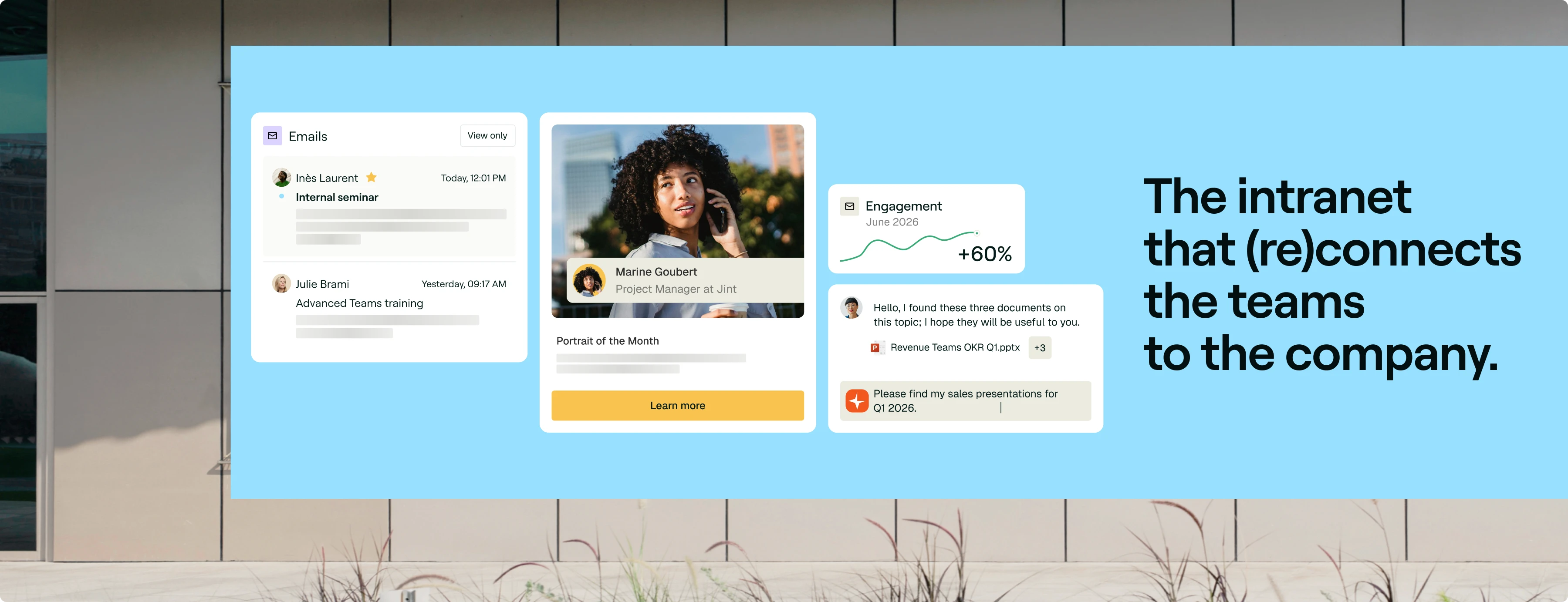Introduction: SharePoint Microsoft 365, the engine of your digital transformation
The renowned collaboration and content management platform, SharePoint, is now a well-established tool among Microsoft 365 users. And for good reason, this solution is a true driver of digital transformation. It allows organizations to create team sites, websites, and intranets that simplify document sharing, collaboration, and workflow management.
Why SharePoint is more than just a tool ?
Microsoft SharePoint, formerly known as Windows SharePoint Services, is software integrated into the Microsoft 365 suite, previously Office 365 or Microsoft Office. More than just a document management and website creation tool, SharePoint Online can be used to build a true digital work environment (DWE).
SharePoint sites can evolve into modern Digital Workplaces, centralizing the information and applications (Microsoft Teams, Excel, PowerPoint, etc.) employees need to stay productive, whether working individually or in teams, on-site or remotely. SharePoint thus plays a key role in transforming work practices (hybrid work, mobility, remote work) and strengthens organizational resilience and performance.
Collaboration, security, and productivity at the core
Over 200,000 organizations have already adopted Microsoft SharePoint. The reason for this success? SharePoint addresses three essential challenges faced by modern businesses and public institutions:
- Enhanced collaboration: Employees can access shared document libraries, communicate in real time or asynchronously, and even co-edit files remotely.
- Improved productivity: SharePoint centralizes all digital work tools and files while allowing users to create workflows or automate tasks through artificial intelligence (AI).
- Data security: Organizations can store and share data securely, thanks to encryption, Microsoft’s cloud infrastructure, and advanced access management.
Want to tackle these three challenges, and more? In this article, Jint (ex Mozzaik365) explains how to make SharePoint 365 the cornerstone of a successful digital transformation. Enjoy the read!
Collaborate effectively with SharePoint Online

Fully integrated into the Microsoft 365 ecosystem and cloud-based, SharePoint Online makes teamwork easier, both on-site and remotely.
A Hub integrated into the Microsoft 365 ecosystem
The SharePoint Online collaboration and document management platform strongly enhances teamwork. It enables businesses and public organizations to create team sites or intranets that centralize all the information and tools employees need.
On these portals, employees can:
- Navigate smoothly between the different applications in their Microsoft 365 productivity suite (Word, Excel, PowerPoint, Outlook, Teams, etc.);
- Easily find their files in a shared document library and co-edit them in real time or asynchronously without leaving their workspace;
- Stay up to date with company news, connect with colleagues, and access learning resources through the Microsoft Viva employee experience platform integrated with Teams and Microsoft 365.
Work together easily, anywhere
Unlike SharePoint Server, which is hosted locally, SharePoint Online runs in the cloud. Authorized users can access their SharePoint sites from a web browser or mobile app.
Wherever they are, employees can access the latest versions of shared documents and edit them collaboratively thanks to real-time synchronization. For example, a team can co-edit a PowerPoint presentation stored in SharePoint directly from its Teams channel.
Boost productivity through automation and artificial intelligence
Microsoft SharePoint includes AI and automation features that make it a powerful productivity solution for organizations.
Power Automate and Power BI: Streamline work and make smarter decisions
With Power Automate, Microsoft 365 users can automate repetitive business processes (contract approvals, leave requests, data logging, etc.) in SharePoint, without coding. The result: fewer errors, higher productivity, and more time for strategic decision-making.
Decision-making itself can also be improved by connecting Power BI, Microsoft’s business intelligence tool, to SharePoint. This integration allows multiple data sources (SharePoint libraries, Excel files, etc.) to be analyzed and visualized in dashboards embedded directly into SharePoint pages. Decision-makers can thus rely on actionable insights to guide their strategy.
Microsoft 365 Copilot: AI driving performance
The Microsoft 365 Copilot conversational assistant integrated into SharePoint is another major asset for enhancing productivity, automating workflows, and strengthening internal collaboration. For example:
- Ready-to-use or custom AI agents instantly retrieve and summarize information stored in SharePoint files or libraries, eliminating time wasted on searching.
- With the rich text editor, users can quickly write or improve content, making it easier and faster to produce presentations, reports, or communication materials.
- AI also enables users to (co)create SharePoint pages from templates and simple prompts, streamlining internal communication and knowledge sharing.
Security and governance: take control of your data in SharePoint
.png)
SharePoint’s intranet solution offers a secure work environment that protects organizations from data leaks, accidental deletions, and cyberattacks.
Secure and compliant data by default
Data hosted in SharePoint Online is stored on Microsoft’s secure servers and protected by its security policies. Advanced security features include:
- Antivirus protection
- Automatic backups
- Data encryption
- Multi-factor authentication (MFA)
- Granular access control and permission management (content access restriction, blocked downloads, activity reports, confidentiality labels, etc.)
SharePoint ensures a high level of security and helps organizations comply with the General Data Protection Regulation (GDPR).
Clear governance to reduce complexity
Microsoft SharePoint also simplifies data governance:
- The structure of SharePoint sites helps organize information by team, department, or project, avoiding resource fragmentation.
- SharePoint can serve as an electronic document management system (EDMS) to manage document lifecycles (creation, modification, archiving) and ensure compliance.
- The logging feature (audit log) makes it possible to trace all actions performed on SharePoint sites (such as sharing, access, and more), with the goal, once again, of minimizing risks.
- Usage policies that define the sharing and classification rules for SharePoint documents are, in turn, a simple way to standardize internal practices, once again with the goal of protecting sensitive data.
How to successfully implement SharePoint
Microsoft SharePoint is a secure collaboration and document management platform that can unlock your organization’s performance. To leverage its potential, follow these best practices during deployment.
Keys to a successful deployment
To ensure smooth implementation:
- Prepare data migration by cleaning and structuring your internal files.
- Customize your SharePoint team or your SharePoint communication site to reflect your company culture and goals.
- Support user adoption through communication campaigns, training, and mentoring programs.
- Implement a change management strategy to help employees embrace transformation.
Pitfalls to avoid ensuring successful SharePoint adoption
At the same time, to ensure your employees adopt SharePoint, avoid several common mistakes:
- Stacking too many tools. For your teams to embrace change, your digital workspace must be ergonomic, well-structured, and pleasant to use.
- Overloading employees with information. Carefully select the data, news, and resources you share on your SharePoint sites, and distribute them only to the relevant audiences to avoid overwhelming staff.
- Underestimating resistance to change. Even a well-known solution like Microsoft 365 can face opposition, which is why implementing a solid change management strategy is essential.
SharePoint’s limits… and how to overcome them

Despite its many strengths, SharePoint has functional and design limitations. However, these shouldn’t discourage you, solutions like Jint SharePoint can help you turn SharePoint into a high-performing, engaging Digital Workplace.
A powerful but sometimes complex interface
SharePoint is a powerful and reliable platform that offers native customization options (layouts, web parts, themes, etc.). However, specific development (for example, via the SharePoint Framework) is often required to optimize the user experience (UX) on SharePoint sites, ensure smooth navigation, and ultimately facilitate employee adoption of the technology.
Generic features that need enhancement
The SharePoint Online intranet solution lacks advanced intranet modules (web parts). As a result, sites built on SharePoint have certain visual and functional limitations. SharePoint is therefore an excellent foundation for building your digital workspace, but to turn it into a high-performing Digital Workplace, you need to enhance it with features tailored to your organization’s specific needs.
Jint SharePoint : transform SharePoint into a modern digital workplace
Jint (ex Mozzaik365) enables you to create a modern, engaging Digital Workplace within SharePoint, with no custom development. Fully integrated with Microsoft 365, it offers:
- A customizable intranet that reflects your brand and adapts to employee preferences.
- Ready-to-use widgets (directory, FAQ, news wall, etc.) to easily enrich your intranet.
- An optimized user experience across devices (mobile, desktop, tablet) to boost engagement and productivity.
Conclusion: SharePoint, a sustainable driver of performance and engagement
The SharePoint collaboration and document management platform is a solid foundation for creating a high-performing, engaging, and sustainable corporate intranet.
Summary of SharePoint’s key benefits
With Microsoft SharePoint, you can:
- Centralize information and tools your employees need to work efficiently on a single portal or dedicated team sites;
- Create a secure digital workspace where your confidential data is protected (encryption, MFA, access management, etc.);
- Streamline internal collaboration, both in-person and remotely, through intranets accessible via a web browser or mobile app;
- Boost individual and collective productivity thanks to seamless Microsoft 365 integration, automation, and AI.
Want to Go Further?
Ready to build your SharePoint-based intranet? With Jint (ex Mozzaik365), overcome SharePoint’s design and functional limitations and easily create the best Digital Workplace for your organization.
👉 Click here to learn more and book your demo.





.webp)



.jpg)
.webp)
.webp)

